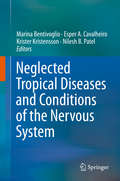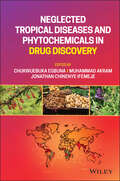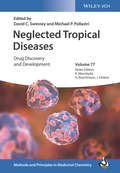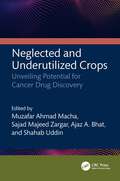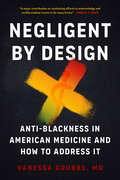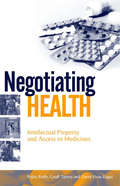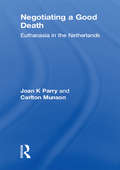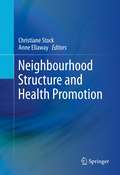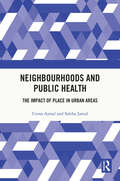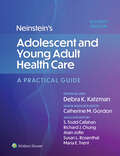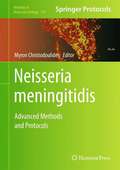- Table View
- List View
Neglected Tropical Diseases and Conditions of the Nervous System
by Esper A. Cavalheiro Marina Bentivoglio Krister Kristensson Nilesh B. PatelA number of diseases and conditions that occur primarily in remote rural or poor urban areas of low-income countries have traditionally been neglected by the neuroscience research community. These diseases and conditions affect the nervous system directly (sometimes with lethal consequences) and/or are associated with severe neurological sequels such as epilepsy, cognitive deficits, and sleep disruption. Several diseases also have the effect of promoting poverty by leaving sufferers unable to lead economically productive lives due to cognitive and behavioral disturbances or severe stigmatization. The pathogenesis of neural dysfunction in the diseases addressed in this book and their sequels remains unclear. Neuroscience of Neglected Diseases and Conditions makes available much needed information about how these diseases affect the human nervous system as well as to promote interest in further research. Further research into neglected diseases and conditions will uncover information that sheds light on more general topics of interest to the neuroscience research community.
Neglected Tropical Diseases and Phytochemicals in Drug Discovery
by Muhammad Akram Chukwuebuka Egbuna Jonathan Chinenye Ifemeje Samrat BhattacharyyaNEGLECTED TROPICAL DISEASES AND PHYTOCHEMICALS IN DRUG DISCOVERY Explore novel drug discovery updates from medicinal plants to help fight the devastating effects of neglected tropical diseases Neglected Tropical Diseases and Phytochemicals in Drug Discovery delivers a comprehensive exploration of the drug discovery process as it pertains to neglected tropical diseases. The book covers recent advancements in drug discovery, as well as druggable targets and new challenges facing the industry. It offers readers expansive discussions of specific diseases, including protozoan, helminth, bacterial, viral, fungal, and ectoparasitic infections. This book provides readers with insightful perspectives from leading industry voices on fifty years of trends and progress in the search for new, safe, and affordable therapeutic drugs in the fight against neglected tropical diseases. It includes information beneficial to researchers in a variety of fields of biology, chemistry, medicine, and pharmaceuticals. The distinguished authors cover topics including the effects of phytochemicals on the causative agent of leprosy and the potential applicability of phytochemicals in the management of Dengue fever. Readers will also enjoy the inclusion of: Thorough introductions to neglected tropical diseases, phytochemicals, protein targets, and mechanisms in drug discovery, as well as the epidemiology of neglected tropical diseases An exploration of novel bioactive lead compounds for drug discovery against neglected tropical diseases, leishmaniasis, lymphatic filariasis, trypanosomiasis, and schistosomiasis Discussions of protozoan infections, including herbal, nutritional, and traditional remedies for giardiasis and the anti-leishmanial potentials of phytochemicals Examinations of helminth infections, including the prospects of phytochemicals in the treatment of helminthiasis Perfect for medicinal chemists, drug developers, and research and development scientists, Neglected Tropical Diseases and Phytochemicals in Drug Discovery will also earn a place in the libraries of toxicologists and researchers in biology, chemistry, medicinal chemistry, ethnobotany, and bioinformatics seeking a one-stop resource for drug discovery for neglected tropical diseases.
Neglected Tropical Diseases: Drug Discovery and Development (Methods and Principles in Medicinal Chemistry)
by Raimund Mannhold Jörg Holenz Helmut BuschmannA drug discovery reference to the crippling tropical diseases that affect more than 1 billion people. Neglected Tropical Diseases is the first book of its kind to offer a guide that follows the World Health Organization?s list of neglected tropical diseases. The authors?all are experts on the topic?address the development of effective treatments for 12 crippling infectious diseases that affect almost 20% of the world?s popluation. The book includes information on the common approaches and the most important factors that lead to the development of new drugs for treating tropical diseases. Individual chapters review 12 neglected tropical diseases that are grouped by infectious agent, from viruses to bacteria to eukaryotic parasites. For each of these diseases, the book explains the unmet medical need and explores the current and potential drug discovery strategies. The book also includes information on potential drug compounds derived from natural products. This important book: -Ties together information from different sources for developing novel treatsments forneglected tropical diseases -Is aligned with WHO?s initiative to eradicate tropical diseases -Outlines current and potential drugs for treating tropical diseases -Provides a standard reference for the entire field Written for medicinal chemists, pharmaceutical chemists, pharmaceutical industry, virologists, parasitologists, and specialists on tropics medicine, Neglected Tropical Diseases offers an essential guide and a systematic reference for the development of successful treatments for 12 crippling infectious diseases.
Neglected and Underutilized Crops: Unveiling Potential for Cancer Drug Discovery
by Sajad Majeed Zargar Muzafar Ahmad Macha Ajaz A. Bhat Shahab UddinThis book provides a comprehensive review of the potential of neglected and underutilized crops in the prevention and treatment of various cancers. It explores various aspects of these crops and their bioactive compounds, shedding light on their role in health and nutrition. The initial chapters discuss neglected and underutilized crops, emphasizing their relevance in human disease and cancer management. These chapters also examine the bioavailability and formulation strategies of bioactive compounds derived from these crops. The book further delves into the isolation, availability, and therapeutic uses of these bioactive compounds, emphasizing their significant role in modern medicine. It also reviews the potential of the Indian gooseberry, quinoa, and seabuckthorn in cancer treatment and management. Additionally, the book discusses neglected medicinal plants of the Northwestern Himalayas, showcasing their potential applications in both traditional and modern medicine. It also highlights the importance of sustainable cultivation and conservation efforts to ensure the long-term availability of these crops. This book is of particular interest to scientists, researchers, and academics in fields such as agriculture, biochemistry, nutrition, and medicine.
Negligent by Design: Anti-Blackness in American Medicine and How to Address It
by Vanessa Grubbs MDA searing critique of medical racism and a powerful call for health-care professionals to make real change in their field, written by a leading activist and doctorUnequal access to care. Misdiagnosis. Mistreatment. Medical gaslighting. An increasing number of studies show the profound impacts racism has on communities of color—particularly Black Americans. But these disparities in health care and wellbeing are not the result of a handful of uninformed or malicious doctors: racism in the medical system is institutional, woven into the very fabric of diagnostic criteria and even hospital infrastructure. Medicine denies fair treatment to Black patients not in error…but by design. Drawing from extensive research, in-depth interviews with medical students and resident physicians, and over twenty-five years of experience as a medical doctor, Dr. Vanessa Grubbs argues that the reason racism in medicine continues to go unchecked is because it is in fact the standard of care. Any attempts to dismantle medical racism through &“placebo&” efforts such as forming diversity committees or releasing statements condemning racism will fail, she says, because they don&’t address the reality of how the institution of Medicine has been, and continues to be, negligent when it comes to the treatment of Black people. Dr. Grubbs skillfully unpacks the three core problems of how our health-care system currently considers the race of patients, which she identifies as being &“race based,&” &“race disregarded,&” and &“race denied.&”When medical diagnoses and trainings are race based, they lead doctors to make different treatment decisions for Black patients, and create a dangerous disadvantage.At the same time, medical textbooks and trainings may inappropriately disregard race in cases when it does matter, like failing to include pictures of how rashes may appear differently on light and dark skin—leading to misdiagnosis and death.And finally, many medical institutions still deny the extent to which racism is an issue at all, resulting in fewer Black physicians and disastrous outcomes for Black patients. Calling on her medical colleagues to join her in working against the negligence of American medicine, Dr. Grubbs lays out a pathway to true equity and inclusion in health care: getting to the root of the underlying fears and insecurities that have led to racist medical negligence; recruiting and retaining a diverse physician workforce; and forcing Medicine to commit to the cultural humility necessary to rebuild, not just replaster, a broken institution.
Negotiating Ageing: Cultural Adaptation to the Prospect of a Long Life (Routledge Key Themes in Health and Society)
by Simon BiggsThe world is growing older and this is a historically unprecedented phenomenon. Negotiating such change, personally, socially and for governments and international organisations requires an act of cultural adaptation. Two key questions arise: What is the purpose of a long life? and How do we adapt to societies where generations are of approximately the same size? A number of pre-existing narratives can be identified; however, it is argued that contemporary policies have produced a premature answer which may eclipse the potential arising from lifecourse change. In this book Simon Biggs discusses ways of interrogating these questions and the adaptations we make to them. Four major areas, all of which have been suggested as solutions to population ageing, are critically assessed, including work as an answer, the relationship between work, ageing and health, narratives of spirit, belief and wisdom, the body and the natural, anti-ageing medicine, critical approaches to dementia, plus family and intergenerational relations. This book is particiularly useful for those trying to make sense of population ageing and negotiate solutions. It describes a number of concepts that can be used to assess what we are told about a long life and how generations can adapt together. With the cultural landscape moving away from traditional interpretations of old age, the question of adult ageing is of growing interest to a number of groups. This book is essential reading for social and health-care workers, other helping professionals, policy makers, social scientists and all who encounter the prospect of a long life.
Negotiating Family Responsibilities
by Jennifer Mason Janet Finch Professor Janet FinchNegotiating Family Responsibilities provides a major new insight into contemporary family life, particularly kin relationships outside the nuclear family. While many people believe that the real meaning of 'family' has shrunk to the nuclear family household, there is considerable evidence to suggest that relationships with the wider kin group remain an important part of most people's lives. Based on the findings of a major study of kinship, and including lively verbatim accounts of conversations with family members concepts of responsibility and obligation within family life are examined and the authors expand theories on the nature of assistance within families and argue that it is negotiated over time rather than given automatically.
Negotiating Global Health Policies: Tensions and Dilemmas (SpringerBriefs in Public Health)
by Germán VelásquezThis book presents reflections and research that highlight tensions in the ongoing negotiations on pandemic preparedness treaties and revisions to the International Health Regulations, underscoring the geopolitical divide between developed and developing countries. It advocates regional health initiatives as a response to the multilateral impasse and reflects on the erosion of foundational public health concepts such as "essential medicines". New pandemics are inevitable. How can we best prepare for them and, above all, how can we avoid the mistakes and injustices made during the COVID-19 pandemic? Negotiations are underway to formulate a binding international treaty on prevention and preparedness to ensure fairer responses to future pandemics. This book is intended as a critical contribution to the current debates. How can equitable access to medicines and diagnostics be guaranteed when they are produced in a small number of countries? How can we explain the fact that current funding for cooperation in the field of health is in the hands of a small group of Northern countries and foundations from the North? How can the role of the World Health Organization be strengthened? WHO now plays only a minor role in coordinating public health policies. How is it that the concept of &“essential medicines&”, a major advance in public health policy, is being replaced by that of &“medical countermeasures&”, a term more in line with the private sectors? Preparing for future pandemics forces us to ask ourselves: how can we safeguard the general interest, the defense of human rights and public health? Negotiating Global Health Policies: Tensions and Dilemmas is essential reading for negotiators from the 194 member countries of the World Health Organization (WHO), the World Trade Organization (WTO), and the World Intellectual Property Organization (WIPO) who participate in international negotiations on health and development. Academics and students of medicine, health sciences, law, sociology and political science, as well as intergovernmental organizations and non-governmental organizations who work on access to medicines and global health issues, also would find the book of interest.
Negotiating Health: Intellectual Property and Access to Medicines
by Pedro Roffe Geoff Tansey David Vivas-EuguiIn developing countries, access to affordable medicines for the treatment of diseases such as AIDS and malaria remains a matter of life or death. In Africa, for instance, more than one million children die each year from malaria alone, a figure which could soon be far higher with the extension of patent rules for pharmaceuticals. Previously, access to essential medicines was made possible by the supply of much cheaper generics, manufactured largely by India; from 2005, however, the availability of these drugs is threatened as new WTO rules take effect. Halting the spread of malaria and HIV/AIDS is one of the eight Millennium Goals adopted at the UN Millennium Summit, which makes this a timely and topical book. Informed analysis is provided by internationally renowned contributors who look at the post-2005 world and discuss how action may be taken to ensure that intellectual property regimes are interpreted and implemented in a manner supportive to the right to protect public health and, in particular, to promote access to medicines for all.
Negotiating Pharmaceutical Uncertainty: Women's Agency in a South African HIV Prevention Trial
by Eirik Saethre Jonathan StadlerTelling the story of a clinical trial testing an innovative gel designed to prevent women from contracting HIV, Negotiating Pharmaceutical Uncertainty provides new insight into the complex and contradictory relationship between medical researchers and their subjects. Although clinical trials attempt to control and monitor participants' bodies, Saethre and Stadler argue that the inherent uncertainty of medical testing can create unanticipated opportunities for women to exercise control over their health, sexuality, and social relationships. Combining a critical analysis of the social production of biomedical knowledge and technologies with a detailed ethnography of the lives of female South African trial participants, this book brings to light issues of economic exclusion, racial disparity, and spiritual insecurity in Johannesburg's townships. Built on a series of tales ranging from strategy sessions at the National Institutes of Health to witchcraft accusations against the trial, Negotiating Pharmaceutical Uncertainty illuminates the everyday social lives of clinical trials.As embedded anthropologists, Saethre and Stadler provide a unique and nuanced perspective of the reality of a clinical trial that is often hidden from view.
Negotiating Pharmaceutical Uncertainty: Women's Agency in a South African HIV Prevention Trial
by Eirik Saethre Jonathan StadlerTelling the story of a clinical trial testing an innovative gel designed to prevent women from contracting HIV, Negotiating Pharmaceutical Uncertainty provides new insight into the complex and contradictory relationship between medical researchers and their subjects. Although clinical trials attempt to control and monitor participants' bodies, Saethre and Stadler argue that the inherent uncertainty of medical testing can create unanticipated opportunities for women to exercise control over their health, sexuality, and social relationships. Combining a critical analysis of the social production of biomedical knowledge and technologies with a detailed ethnography of the lives of female South African trial participants, this book brings to light issues of economic exclusion, racial disparity, and spiritual insecurity in Johannesburg's townships. Built on a series of tales ranging from strategy sessions at the National Institutes of Health to witchcraft accusations against the trial, Negotiating Pharmaceutical Uncertainty illuminates the everyday social lives of clinical trials. As embedded anthropologists, Saethre and Stadler provide a unique and nuanced perspective of the reality of a clinical trial that is often hidden from view.
Negotiating Public Health in a Globalized World
by Nick Drager David Fairman Diana Chigas Elizabeth McclintockIn a new era of global health diplomacy, the most important tool for decision-making is negotiation. Globalization is binding countries, issues and people together as never before. In the domain of public health, traditional international concerns like the spread of infectious diseases have been joined by new concerns and challenges in managing the health impacts of trade and intellectual property rights, and by new opportunities to create effective global public health agreements and programs. To address the major health crises of today and to prevent or mitigate them in the future, countries must seek collective agreement and action within and across their borders. However, the world of international negotiation is not the world in which health decision-makers reside or are most comfortable. The goal of this guide is to provide health policy-makers with practical information and negotiation tools, to help them create better international health agreements and programs. "This is the best book I know to help health professionals develop the negotiation skills necessary to meet the challenges of global health diplomacy. It is filled with wise advice and invaluable tools for success." Professor Jeswald W. Salacuse, The Fletcher School of Law and Diplomacy, Tufts University
Negotiating a Good Death: Euthanasia in the Netherlands
by Carlton Munson Joan K ParrySocial Work Theory and Practice with the Terminally Ill, second edition, takes a compassionate look at ways that social workers can help dying people and their families. The social workers who work most effectively with terminally ill patients and their families are the ones who best understand the multifaceted nature of the dying process and its impact on the the patient, the family, and even on the health care professionals who work with patients at the end of life. Dr. Parry--who specializes in dying and bereavement--offers astute observations on the stages of dealing with the diagnosis of a terminal illness and the impending death that patients and their families confront. This updated second edition provides valuable new information on ways that social workers can help those with AIDS and their families, on traumatic death from any cause, and on the grieving processes of parents.Social Work Theory and Practice with the Terminally Ill, second edition, also includes stimulating discussions on: the interdisciplinary health team the grieving process professional burnout how social workers adapt to working with dying patients euthanasia and physician-assisted dying living wills and patients’rightsIn touching case studies, this volume illustrates the particular needs and concerns of the terminally ill and their families--impending losses, financial worries, job concerns, pain, unfinished business, and spiritual needs--and reviews successful interventions used by social workers to help patients and their families work through the dying process.
Negotiating a Good Death: Euthanasia in the Netherlands
by Carlton Muson Joan K PerryShould human beings be allowed to decide when to die? Should doctors be allowed to assist them?During the last ten years there has been much international interest in euthanasia in the Netherlands. In the discussion of euthanasia in the US and the UK, both sides in the debate continually refer to the “Dutch Experience”. Negotiating a Good Death: Euthanasia in the Netherlands presents firsthand descriptions of euthanasia in practice in the Netherlands--something that has never been done before. This will provide a deeper understanding of the issues involved for all those interested in end-of-life decisions. It will also help clinicians and other medical professionals better understand end-of-life decision making.Negotiating a Good Death is the first inside account of how decisions about euthanasia are made in real-life situations. Documenting two years of observations at a Dutch hospital, this valuable book describes why patients request euthanasia, the social factors that influence doctors’decisions about granting patients’requests, and how patients and doctors confer over peaceful deaths. Some aspects of this delicate, often hidden, and socially taboo subject that Negotiating a Good Death frankly discusses are: the emotions that lead to a wish for death the ideology of easy death the anthropology of death the role of the researcher the line between symptom alleviation and euthanasia where the responsibility lies conservative options for medical personnel how to speak to relatives of someone who has requested euthanasia euthanasia as a cultural constructThrough case studies and examples, Negotiating a Good Death: Euthanasia in the Netherlands will help you understand the issues surrounding euthanasia and how life-ending decisions are made by both doctors and patients.
Negotiating the Emotional Challenges of Conducting Deeply Personal Research in Health
by J. E. Sumerau Alexandra Xan" NowakowskiPublic health researchers and clinicians regularly work with people who have suffered physical and mental trauma. Knowing how to conduct a study or treat a patient while navigating deep emotional issues requires special skills and overall awareness of how trauma can impact the process and outcomes of participating in research and/or receiving health care. This book presents a diverse array of case examples from scholars of health-related topics, focusing on biographical narrative as a window into understanding key needs in trauma informed scholarship and medicine. Exploring stories from people of varied backgrounds, experiences, and contexts can help professionals within and beyond the academic research and clinical care spheres create rewarding experiences for patients. Negotiating the Emotional Challenges of Conducting Deeply Personal Research in Health will be of interest to public health practitioners, educators and researchers as well as students.
Neighborhoods, Communities and Child Maltreatment: A Global Perspective (Child Maltreatment #15)
by Carmit Katz Kathryn Maguire-JackThis volume explores methods for studying child maltreatment in the context of neighborhoods and communities, given their importance in the lives of families. It discusses the ways in which neighborhoods have changed over time and how this that has impacted parenting in the modern context. It also highlights the ways in which policies have contributed to persistent poverty and inequality, which indirectly impacts child maltreatment. An important focus of this volume is to examine the multitude of ways in which the neighborhood context affects families, including structural factors like poverty, segregation, residential instability, and process factors like social cohesion. The volume takes a critical look at the ways in which culture and context affect maltreatment through a community-based approach, and uses this approach to understand child maltreatment in rural areas. The editors and contributors explore innovative prevention approaches and reflect on the future of this field in terms of what remains unknown, how the information should be used to guide policy in the future, and how practitioners can best support parents while being mindful of the importance of context. Addressing an important topic, this volume is of relevance and interest to a wide readership of scholars and students in the social and behavioral sciences, as well as to practitioners and policy makers working with neighborhoods and communities.
Neighbourhood Effects Research: New Perspectives
by Nick Bailey Duncan Maclennan Ludi Simpson Maarten Van Ham David ManleyOver the last 25 years a vast body of literature has been published on neighbourhood effects: the idea that living in more deprived neighbourhoods has a negative effect on residents' life chances over and above the effect of their individual characteristics. The volume of work not only reflects academic and policy interest in this topic, but also the fact that we are still no closer to answering the question of how important neighbourhood effects actually are. There is little doubt that these effects exist, but we do not know enough about the causal mechanisms which produce them, their relative importance in shaping individual's life chances, the circumstances or conditions under which they are most important, or the most effective policy responses. Collectively, the chapters in this book offer new perspectives on these questions, and refocus the academic debate on neighbourhood effects. The book enriches the neighbourhood effects literature with insights from a wide range of disciplines and countries.
Neighbourhood Effects or Neighbourhood Based Problems?: A Policy Context
by Nick Bailey Duncan Maclennan Ludi Simpson Maarten Van Ham David ManleyThis edited volume critically examines the link between area based policies, neighbourhood based problems, and neighbourhood effects: the idea that living in disadvantaged neighbourhoods has a negative effect on residents' life chances over and above the effect of their individual characteristics. Over the last few decades, Western governments have persistently pursued area based policies to fight such effects, despite a lack of evidence that they exist, or that these policies make a difference. The first part of this book presents case studies of perceived neighbourhood based problems in the domains of crime; health; educational outcomes; and employment. The second part of the book presents an international overview of the policies that different governments have implemented in response to these neighbourhood based problems, and discusses the theoretical and conceptual processes behind place based policy making. Case studies are drawn from a diverse range of countries including the United Kingdom, The Netherlands, Australia, Canada, and the USA.
Neighbourhood Structure and Health Promotion
by Christiane Stock Anne EllawayIt has long been theorized that people living in poor areas have more health problems than their more advantaged peers. More recently, science has been testing this hypothesis, concentrating on the impact of the built environment on well-being and its contribution to health inequities. Neighbourhood Structure and Health Promotion offers sociology-based theory and evidence-based findings so readers may better understand the effects of place on health choices, behaviour, and outcomes. This international volume analyzes the complex relationships among neighbourhood conditions and characteristics, people's perceptions of where they live, and their everyday health lives, from eating habits and activity levels to smoking, drinking, and drug use. Chapters introduce innovative methods for measuring and monitoring links between place and health in terms of risks and resources, and employing objective and subjective data. Prospects for engaging neighbourhoods in prevention efforts, particularly involving young people, and policy implications for the future of health promotion and inequity reduction are discussed as well. Included in the coverage: The spatiality of injustice: area effects on behaviour.Qualitative and quantitative methods for assessing neighbourhood health resources.The potential of GIS and GPS in the health sciences.Green spaces and health: possibilities for research and policy.School neighbourhoods and obesity prevention in youth.Connecting gender, social environment, and health.Neighbourhood Structure and Health Promotion advances the study of this increasingly critical topic, making it a valuable reference for researchers, practitioners, policy makers and advanced students in health, health promotion, social epidemiology, and urban planning.
Neighbourhoods and Public Health: The Impact of Place in Urban Areas
by Saleha Jamal Uzma AjmalThis book examines the concept of neighbourhood over space and time and understands how neighbourhoods can impact human health and well-being. It discusses the identification of neighbourhood boundaries, features of individual neighbourhoods, and the concept of neighbourhood in some major world as well as Indian cities. Based on extensive research, this study refers to both primary as well as secondary sources of data using various statistical and geo-spatial techniques. The first section of the book focuses on the concept of neighbourhood, concept of neighbourhood unit, methods used in the identification of neighbourhood boundaries and theories related to neighbourhood effects on health. The subsequent section of the book deals with a case study on neighbourhood effects on health in an Indian city. The case study is followed by a comparison of its results with other global studies. This book will be useful to the departments of Geography, Public Health, Sociology and Social Work. It will also be of use to professionals and practitioners like city planners, architects, NGOs, Environmentalists, and urban policy makers.
Neinstein's Adolescent and Young Adult Health Care: A Practical Guide
by Catherine M. Gordon S. Todd Callahan Richard J. Chung Alain Joffe Susan L. Rosenthal Marie E. TrentThe #1 choice for more than 35 years for those involved in the care of adolescents and young adults, Neinstein’s Adolescent and Young Adult Health: A Practical Guide, 7th Edition is your go-to resource for practical, authoritative guidance. The fully updated seventh edition, edited by Drs. Debra K. Katzman, Catherine M. Gordon, S. Todd Callahan, Richard J. Chung, Alain Joffe, Susan L. Rosenthal, and Maria E. Trent, offers a comprehensive view of the interdisciplinary nature of the field and is inclusive of the wide variety of health professionals who care for adolescents and young adults. This award-winning text features a full-color design, several new chapters, numerous algorithms, bulleted text throughout for quick reference at the point of care, and fresh perspectives from new editors—making it ideal for daily practice or certification examination preparation.
Neisseria gonorrhoeae: Methods and Protocols (Methods in Molecular Biology #1997)
by Myron ChristodoulidesThis detailed book addresses the continual development and application of new methods and protocols to understand the biology of the pathogen Neisseria gonorrhoeae. Beginning with gonococcus biology and antimicrobial resistance, the volume continues with areas of study such as producing major gonococcal antigens to high purity, genetic transformation of gonococci and strategies for global RNA sequencing, evaluation of potential vaccine/drug targets and the assessment of hypothetical protein function, as well as a number of methods and protocols for studying the biological interactions of the gonococcus and the host. Written for the highly successful Methods in Molecular Biology series, chapters include introductions to their respective topics, lists of the necessary materials and reagents, step-by-step, readily reproducible laboratory protocols, and tips on troubleshooting and avoiding known pitfalls. Comprehensive and cutting-edge, Neisseria gonorrhoeae: Methods and Protocols provides researchers with a foundation for progress toward the eventual control of this disease and a significant reduction in global case numbers of gonorrhea.
Neisseria meningitidis: Advanced Methods and Protocols (Methods in Molecular Biology #799)
by Myron ChristodoulidesNeisseria meningitidis is a major causative agent, worldwide, of potentially life-threatening meningitis and septicaemia, which carry with them a high mortality rate and permanent physical and neurological issues for survivors. Neisseria meningitidis: Advanced Methods and Protocols offers a collection of methods and protocols that reflect the development and refinement of several new technologies applied to the meningococcus as presented by expert researchers. Several of the chapters in this book describe methods that rely on the collection of complete sets of biological data, for example, using the genome to generate transcriptomes, proteomes, and metabolomes. Written in the highly successful Methods in Molecular BiologyTM series format, chapters include introductions to their respective topics, lists of the necessary materials and reagents, step-by-step, readily reproducible laboratory protocols, and tips on troubleshooting and avoiding known pitfalls. Authoritative and cutting-edge, Neisseria meningitidis: Advanced Methods and Protocols can be readily used to study other pathogens and diseases and should have broad appeal to clinical and non-clinical scientists alike; however, there is still much to learn about the meningococcus and its complex nature, which in turn continues to reveal crucial details about human biology as well.
Nelson Textbook Of Pediatrics
by Richard E. Behrman Robert M. Kliegman Bonita Stanton Joseph St. Geme Nina F. Schor"The coverage of such a wide range of subjects relating to child health makes this textbook still the gold standard and companion for all pediatricians across the world. " By Neel Kamal, Sep 2015 "All in all, this is an excellent and detailed paediatric review textbook which represents excellent value for money. . truly a textbook for the global community" By glycosmedia. com, Sep 2015 Form a definitive diagnosis and create the best treatment plans possible using evidence-based medicine and astute clinical experiences from leading international authors-many new to this edition. A NEW two-volume layout provides superior portability and exceptional ease of use. Gain a more complete perspective. Along with a broader emphasis on imaging and molecular diagnoses and updated references, the new edition includes an increased focus on international issues to ensure relevance in pediatrics practice throughout the world. Effectively apply the latest techniques and approaches with complete updates throughout 35 new chapters, including: Innovations in Addressing Child Health and Survival in Low Income Settings; Developmental Domains and Theories of Cognition; The Reggio Emilia Educational Approach Catatonia ; Refeeding Syndrome; Altitude-associated Illness; Genetic Approaches to Rare and Undiagnosed Diseases; Healthcare-Associated Infections; Intrapartum and Peripartum Infections; Bath salts and other drugs of abuse; Small Fiber Polyneuropathy; Microbiome; Kingella kingae; Mitochondrial Neurogastrointestinal Encephalomyopathy; Nonalcoholic Fatty Liver Disease; Plagiocephaly; CNS Vasculitis; Anterior Cruciate Ligament Rupture; and Sports-Related Traumatic Brain Injury. Recognize, diagnose, and manage genetic and acquired conditions more effectively. A new Rehabilitation section with 10 new chapters, including: Evaluation of the Child for Rehabilitative Services; Severe Traumatic Brain Injury; Spinal Cord Injury and Autonomic Crisis Management; Spasticity; Birth Brachial Plexus Palsy; Traumatic and Sports-Related Injuries; Meningomyeloce≤ Health and Wellness for Children with Disabilities. Manage the transition to adult healthcare for children with chronic diseases through discussions of the overall health needs of patients with congenital heart defects, diabetes, and cystic fibrosis. Understand the principles of therapy and which drugs and dosages to prescribe for every disease. Expert Consult eBook version included with purchase. This enhanced eBook experience allows you to search all of the text, figures, and references from the book on a variety of devices.
Nelson Textbook Of Pediatrics
by Richard E. Behrman Robert M. Kliegman Bonita Stanton Joseph St. Geme Nina F. SchorAfter more than 75 years, Nelson Textbook of Pediatrics remains your indispensable source for definitive, state-of-the-art answers on every aspect of pediatric care. Embracing the new advances in science as well as the time-honored art of pediatric practice, this classic reference provides the essential information that practitioners and other care providers involved in pediatric health care throughout the world need to understand to effectively address the enormous range of biologic, psychologic, and social problems that our children and youth may face. Brand-new chapters and comprehensive revisions throughout ensure that you have the most recent information on diagnosis and treatment of pediatric diseases based on the latest recommendations and methodologies. "The coverage of such a wide range of subjects relating to child health makes this textbook still the gold standard and companion for all pediatricians across the world. " Reviewed by Neel Kamal, Sept 2015 "All in all, this is an excellent and detailed paediatric review textbook which represents excellent value for money. . truly a textbook for the global community" Reviewed by glycosmedia. com, Sept 2015 Form a definitive diagnosis and create the best treatment plans possible using evidence-based medicine and astute clinical experiences from leading international authors-many new to this edition. A NEW two-volume layout provides superior portability and exceptional ease of use. Gain a more complete perspective. Along with a broader emphasis on imaging and molecular diagnoses and updated references, the new edition includes an increased focus on international issues to ensure relevance in pediatrics practice throughout the world. Effectively apply the latest techniques and approaches with complete updates throughout 35 new chapters, including: Innovations in Addressing Child Health and Survival in Low Income Settings; Developmental Domains and Theories of Cognition; The Reggio Emilia Educational Approach Catatonia ; Refeeding Syndrome; Altitude-associated Illness; Genetic Approaches to Rare and Undiagnosed Diseases; Healthcare-Associated Infections; Intrapartum and Peripartum Infections; Bath salts and other drugs of abuse; Small Fiber Polyneuropathy; Microbiome; Kingella kingae; Mitochondrial Neurogastrointestinal Encephalomyopathy; Nonalcoholic Fatty Liver Disease; Plagiocephaly; CNS Vasculitis; Anterior Cruciate Ligament Rupture; and Sports-Related Traumatic Brain Injury. Recognize, diagnose, and manage genetic and acquired conditions more effectively. A new Rehabilitation section with 10 new chapters, including: Evaluation of the Child for Rehabilitative Services; Severe Traumatic Brain Injury; Spinal Cord Injury and Autonomic Crisis Management; Spasticity; Birth Brachial Plexus Palsy; Traumatic and Sports-Related Injuries; Meningomyeloce≤ Health and Wellness for Children with Disabilities. Manage the transition to adult healthcare for children with chronic diseases through discussions of the overall health needs of patients with congenital heart defects, diabetes, and cystic fibrosis. Understand the principles of therapy and which drugs and dosages to prescribe for every disease. Expert Consult eBook version included with purchase. This enhanced eBook experience allows you to search all of the text, figures, and references from the book on a variety of devices.
